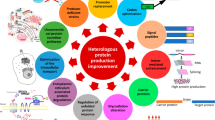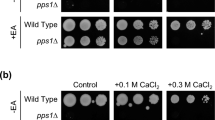Abstract
This report describes the analyses of three Candida albicans genes that encode Src Homology 3 (SH3)-domain proteins. Homologs in Saccharomyces cerevisiae are encoded by the SLA1, NBP2, and CYK3 genes. Deletion of CYK3 in C. albicans was not feasible, suggesting it is essential. Promoter shutdown experiments of CaCYK3 revealed cytokinesis defects, which are in line with the localization of GFP-tagged Cyk3 at septal sites. Deletion of SLA1 resulted in strains with decreased ability to form hyphal filaments. The number of cortical actin patches was strongly reduced in Δsla1 strains during all growth stages. Sla1-GFP localizes in patches that are found concentrated at the hyphal tip. Deletion of the first two SH3-domains of Sla1 still resulted in cortical localization of the truncated protein. However, the actin cytoskeleton in this strain was aberrant like in the Δsla1 deletion mutant indicating a function of these SH3 domains to recruit actin nucleation to sites of endocytosis. Deletion of NBP2 resulted in a defect in vacuolar fusion in hyphae. Germ cells of Δnbp2 strains lacked a large vacuole but initiated several germ tubes. The mutant phenotypes of Δnbp2 and Δsla1 could be corrected by reintegration of the wild-type genes.







Similar content being viewed by others
References
am Busch MS, Mignon D, Simonson T (2009) Computational protein design as a tool for fold recognition. Proteins 77:139–158
Barelle CJ, Richard ML, Gaillardin C, Gow NA, Brown AJ (2006) Candida albicans VAC8 is required for vacuolar inheritance and normal hyphal branching. Eukaryot Cell 5:359–367
Bassilana M, Blyth J, Arkowitz RA (2003) Cdc24, the GDP-GTP exchange factor for Cdc42, is required for invasive hyphal growth of Candida albicans. Eukaryot Cell 2:9–18
Bauer J, Wendland J (2007) Candida albicans Sfl1 suppresses flocculation and filamentation. Eukaryot Cell 6:1736–1744
Berman J, Sudbery PE (2002) Candida albicans: a molecular revolution built on lessons from budding yeast. Nat Rev Genet 3:918–930
Calderone RA, Fonzi WA (2001) Virulence factors of Candida albicans. Trends Microbiol 9:327–335
Care RS, Trevethick J, Binley KM, Sudbery PE (1999) The MET3 promoter: a new tool for Candida albicans molecular genetics. Mol Microbiol 34:792–798
Court H, Sudbery P (2007) Regulation of Cdc42 GTPase activity in the formation of hyphae in Candida albicans. Mol Biol Cell 18:265–281
Enloe B, Diamond A, Mitchell AP (2000) A single-transformation gene function test in diploid Candida albicans. J Bacteriol 182:5730–5736
Epp JA, Chant J (1997) An IQGAP-related protein controls actin-ring formation and cytokinesis in yeast. Curr Biol 7:921–929
Gillum AM, Tsay EY, Kirsch DR (1984) Isolation of the Candida albicans gene for orotidine-5′-phosphate decarboxylase by complementation of S. cerevisiae ura3 and E. coli pyrF mutations. Mol Gen Genet 198:179–182
Gola S, Martin R, Walther A, Dunkler A, Wendland J (2003) New modules for PCR-based gene targeting in Candida albicans: rapid and efficient gene targeting using 100 bp of flanking homology region. Yeast 20:1339–1347
Karkkainen S, Hiipakka M, Wang JH, Kleino I, Vaha-Jaakkola M, Renkema GH, Liss M, Wagner R, Saksela K (2006) Identification of preferred protein interactions by phage-display of the human Src homology-3 proteome. EMBO Rep 7:186–191
Korinek WS, Bi E, Epp JA, Wang L, Ho J, Chant J (2000) Cyk3, a novel SH3-domain protein, affects cytokinesis in yeast. Curr Biol 10:947–950
Kumamoto CA, Vinces MD (2005) Contributions of hyphae and hypha-co-regulated genes to Candida albicans virulence. Cell Microbiol 7:1546–1554
Martin R, Hellwig D, Schaub Y, Bauer J, Walther A, Wendland J (2007) Functional analysis of Candida albicans genes whose Saccharomyces cerevisiae homologues are involved in endocytosis. Yeast 24:511–522
Mayer BJ (2001) SH3 domains: complexity in moderation. J Cell Sci 114:1253–1263
Michel S, Ushinsky S, Klebl B, Leberer E, Thomas D, Whiteway M, Morschhauser J (2002) Generation of conditional lethal Candida albicans mutants by inducible deletion of essential genes. Mol Microbiol 46:269–280
Nobile CJ, Mitchell AP (2009) Large-scale gene disruption using the UAU1 cassette. Methods Mol Biol 499:175–194
Noble SM, Johnson AD (2005) Strains and strategies for large-scale gene deletion studies of the diploid human fungal pathogen Candida albicans. Eukaryot Cell 4:298–309
Oberholzer U, Marcil A, Leberer E, Thomas DY, Whiteway M (2002) Myosin I is required for hypha formation in Candida albicans. Eukaryot Cell 1:213–228
Odds FC (1994) Pathogenesis of Candida infections. J Am Acad Dermatol 31:S2–S5
Ohkuni K, Okuda A, Kikuchi A (2003) Yeast Nap1-binding protein Nbp2p is required for mitotic growth at high temperatures and for cell wall integrity. Genetics 165:517–529
Pruyne D, Bretscher A (2000a) Polarization of cell growth in yeast. J Cell Sci 113:571–585
Pruyne D, Bretscher A (2000b) Polarization of cell growth in yeast. I. Establishment and maintenance of polarity states. J Cell Sci 113:365–375
Schaub Y, Dunkler A, Walther A, Wendland J (2006) New pFA-cassettes for PCR-based gene manipulation in Candida albicans. J Basic Microbiol 46:416–429
Sudbery P, Gow N, Berman J (2004) The distinct morphogenic states of Candida albicans. Trends Microbiol 12:317–324
Tang HY, Xu J, Cai M (2000) Pan1p, End3p, and S1a1p, three yeast proteins required for normal cortical actin cytoskeleton organization, associate with each other and play essential roles in cell wall morphogenesis. Mol Cell Biol 20:12–25
Veses V, Gow NA (2008) Vacuolar dynamics during the morphogenetic transition in Candida albicans. FEMS Yeast Res 8:1339–1348
Veses V, Richards A, Gow NA (2009) Vacuole inheritance regulates cell size and branching frequency of Candida albicans hyphae. Mol Microbiol 71:505–519
Walther A, Wendland J (2003) An improved transformation protocol for the human fungal pathogen Candida albicans. Curr Genet 42:339–343
Walther A, Wendland J (2004a) Apical localization of actin patches and vacuolar dynamics in Ashbya gossypii depend on the WASP homolog Wal1p. J Cell Sci 117:4947–4958
Walther A, Wendland J (2004b) Polarized hyphal growth in Candida albicans requires the Wiskott–Aldrich Syndrome protein homolog Wal1p. Eukaryot Cell 3:471–482
Walther A, Wendland J (2008) PCR-based gene targeting in Candida albicans. Nat Protoc 3:1414–1421
Warren DT, Andrews PD, Gourlay CW, Ayscough KR (2002) Sla1p couples the yeast endocytic machinery to proteins regulating actin dynamics. J Cell Sci 115:1703–1715
Weisman LS, Bacallao R, Wickner W (1987) Multiple methods of visualizing the yeast vacuole permit evaluation of its morphology and inheritance during the cell cycle. J Cell Biol 105:1539–1547
Wendland J (2001) Comparison of morphogenetic networks of filamentous fungi and yeast. Fungal Genet Biol 34:63–82
Wendland J, Philippsen P (2002) An IQGAP-related protein, encoded by AgCYK1, is required for septation in the filamentous fungus Ashbya gossypii. Fungal Genet Biol 37:81–88
Winzeler EA, Shoemaker DD, Astromoff A, Liang H, Anderson K, Andre B, Bangham R, Benito R, Boeke JD, Bussey H, Chu AM, Connelly C, Davis K, Dietrich F, Dow SW, El Bakkoury M, Foury F, Friend SH, Gentalen E, Giaever G, Hegemann JH, Jones T, Laub M, Liao H, Liebundguth N, Lockhart DJ, Lucau-Danila A, Lussier M, M’Rabet N, Menard P, Mittmann M, Pai C, Rebischung C, Revuelta JL, Riles L, Roberts CJ, Ross-MacDonald P, Scherens B, Snyder M, Sookhai-Mahadeo S, Storms RK, Veronneau S, Voet M, Volckaert G, Ward TR, Wysocki R, Yen GS, Yu K, Zimmermann K, Philippsen P, Johnston M, Davis RW (1999) Functional characterization of the S. cerevisiae genome by gene deletion and parallel analysis. Science 285:901–906
Zheng XD, Lee RT, Wang YM, Lin QS, Wang Y (2007) Phosphorylation of Rga2, a Cdc42 GAP, by CDK/Hgc1 is crucial for Candida albicans hyphal growth. EMBO J 26:3760–3769
Acknowledgments
We thank Alexander Johnson, Suzanne Noble, and Aaron Mitchell for generously providing reagents used in this study; Sidsel Ehlers for providing technical assistance and Andrea Walther for support on microscopy. This study was funded by the EU-Marie Curie Research Training Network “Penelope” and we thank members of this consortium for discussions.
Author information
Authors and Affiliations
Corresponding author
Additional information
Communicated by C. D'Enfert.
Rights and permissions
About this article
Cite this article
Reijnst, P., Jorde, S. & Wendland, J. Candida albicans SH3-domain proteins involved in hyphal growth, cytokinesis, and vacuolar morphology. Curr Genet 56, 309–319 (2010). https://doi.org/10.1007/s00294-010-0301-7
Received:
Revised:
Accepted:
Published:
Issue Date:
DOI: https://doi.org/10.1007/s00294-010-0301-7




